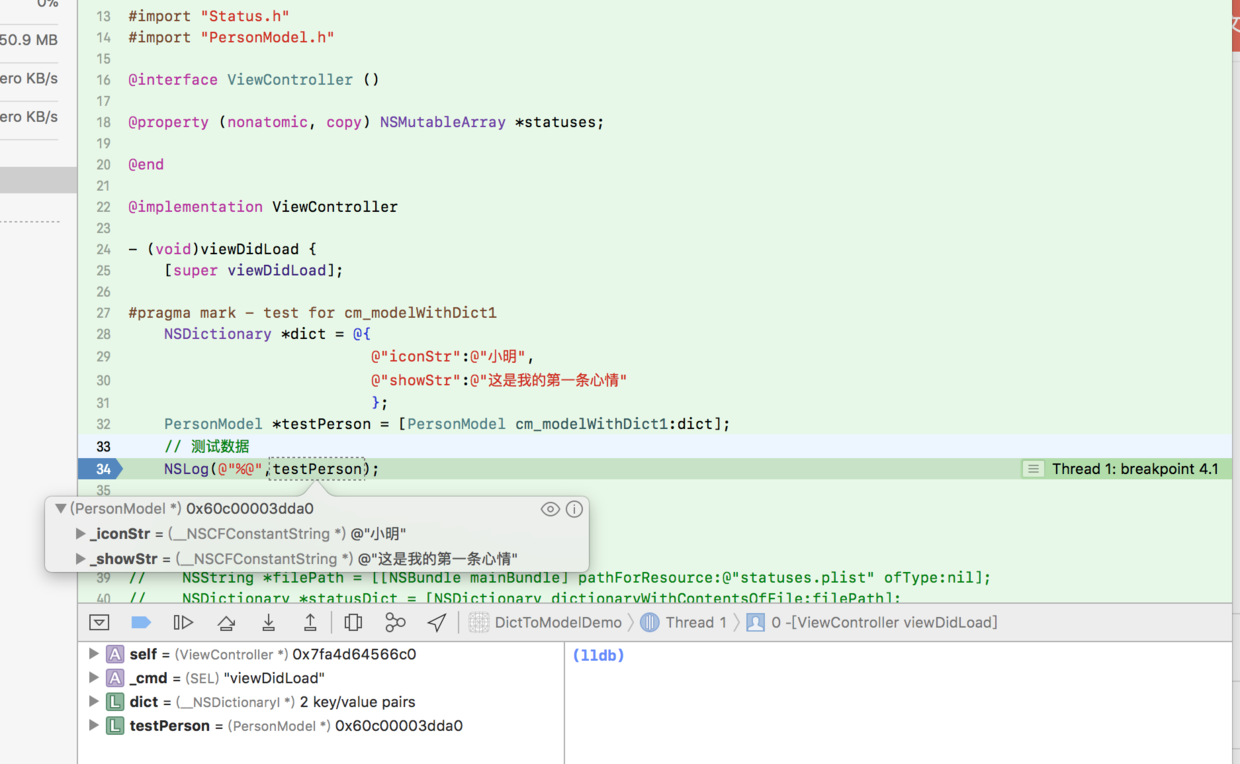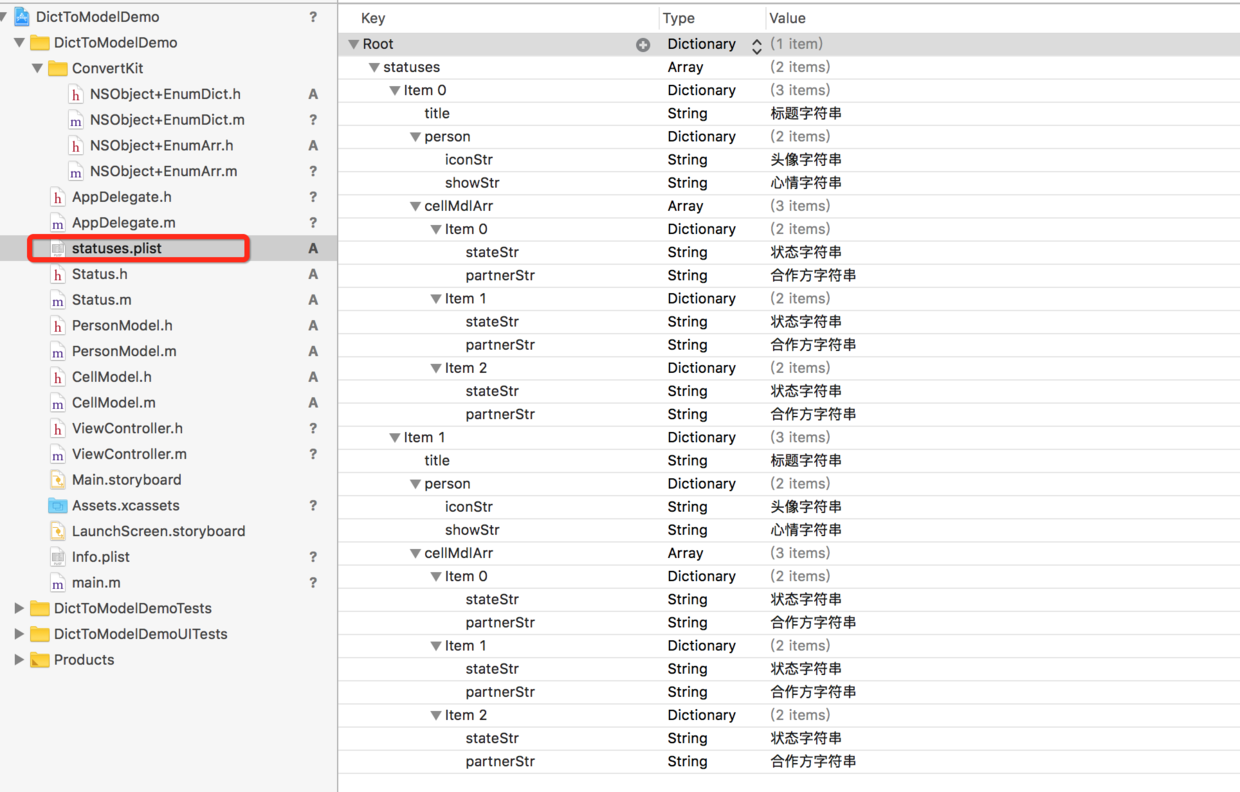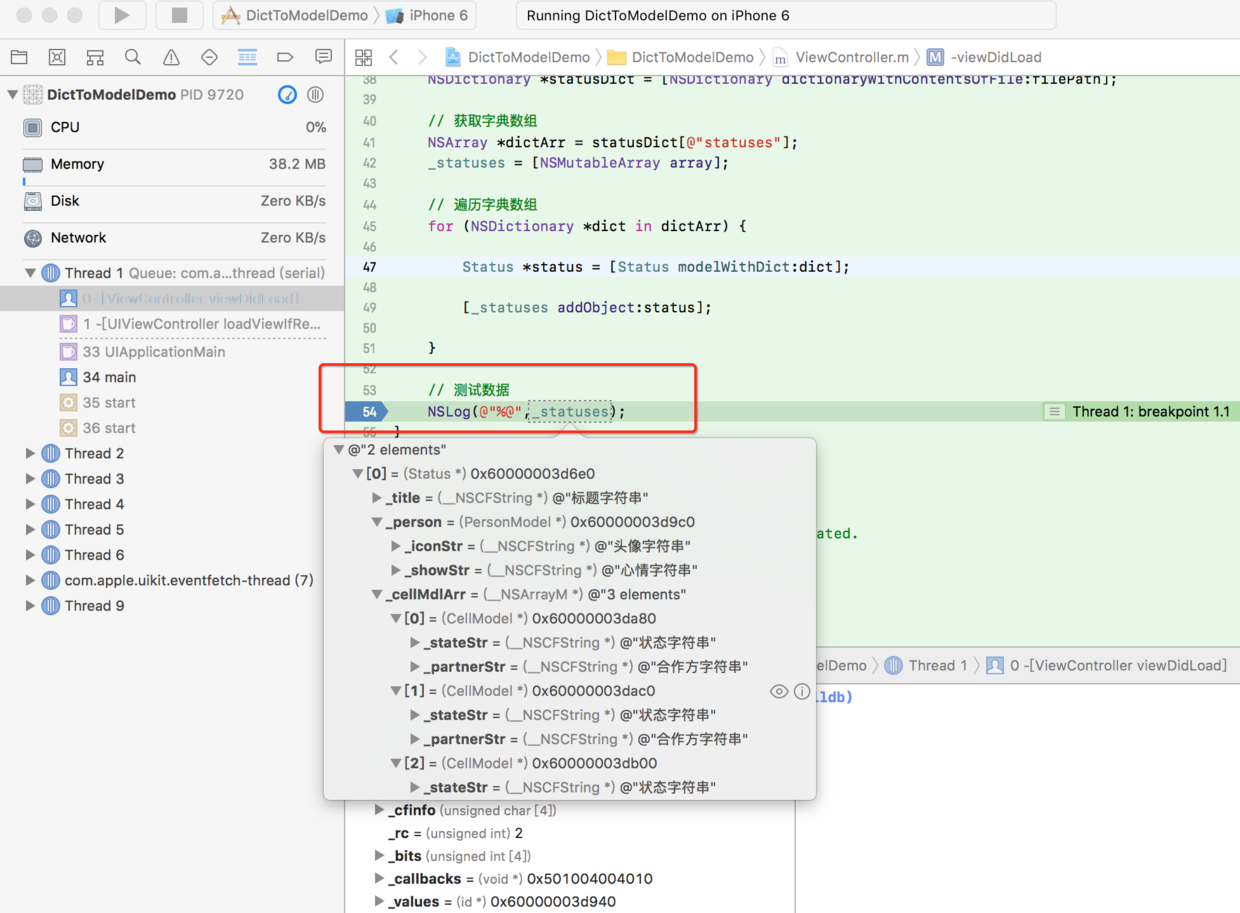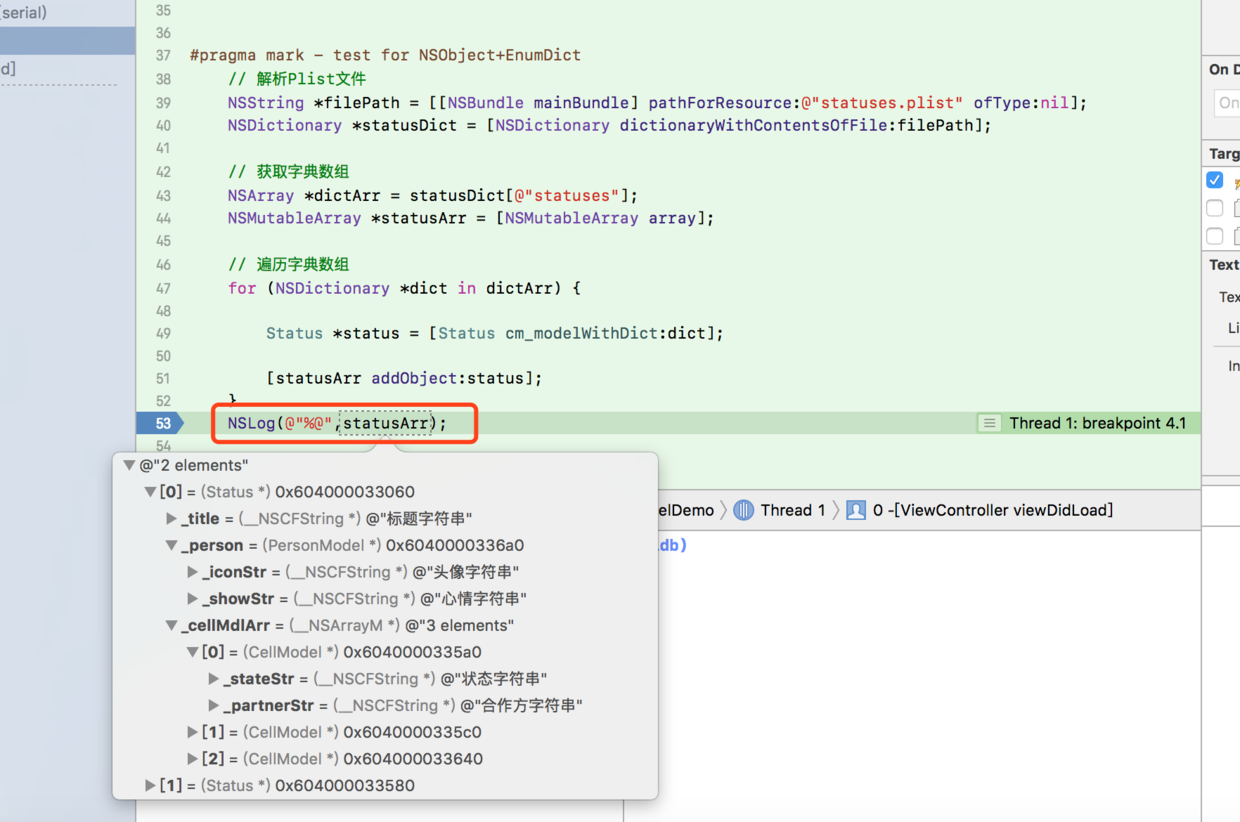本文实验Demo传送门:DictToModelDemo
前言:将后台JSON数据中的字典转成本地的模型,我们一般选用部分优秀的第三方框架,如SBJSON、JSONKit、MJExtension、YYModel等。但是,一些简单的数据,我们也可以尝试自己来实现转换的过程。
更重要的是,有时候在iOS面试的时候,部分面试官会不仅问你某种场景会用到什么框架,更会问你如果要你来实现这个功能,你有没有解决思路?所以,自己实现字典转模型还是有必要掌握的。有了这个基础,在利用运行时runtime的动态特性,你也可以实现这些第三方框架。
笔者的KVC系列为:
1. 字典转模型:KVC
当对象的属性很多的时候,我们可以利用KVC批量设置。
- (void)setValuesForKeysWithDictionary:(NSDictionary<NSString *,id> *)keyedValues;
但是KVC批量转的时候,有个致命的缺点,就是当字典中的键,在对象属性中找不到对应的属性的时候会报错。解决办法是实现下面的方法:
//空的方法体也行
- (void)setValue:(id)value forUndefinedKey:(NSString *)key{}
需求:有一个排名列表页面,这个页面的每个排名对应一个模型,这个模型从Plist转换得到。那么实现的代码如下所示:
- 头文件
#import <Foundation/Foundation.h>
@interface GloryListModel : NSObject
//图标
@property (nonatomic, copy) NSString *icon;
//标题
@property (nonatomic, copy) NSString *title;
//目标控制器
@property (nonatomic, copy) NSString *targetVC;
//菜单编号
@property (nonatomic, copy) NSString *menuCode;
+ (instancetype)gloryListModelWithDict:(NSDictionary *)dict;
+ (NSArray<GloryListModel *> *)gloryListModelsWithPlistName:(NSString *)plistName;
@end
- 实现文件
#import "GloryListModel.h"
@implementation GloryListModel
//kvc实现字典转模型
- (instancetype)initWithDict:(NSDictionary *)dict{
if (self = [super init]) {
[self setValuesForKeysWithDictionary:dict];
}
return self;
}
//防止与后台字段不匹配而造成崩溃
- (void)setValue:(id)value forUndefinedKey:(NSString *)key{}
+ (instancetype)gloryListModelWithDict:(NSDictionary *)dict;{
return [[self alloc]initWithDict:dict];
}
+ (NSArray<GloryListModel *> *)gloryListModelsWithPlistName:(NSString *)plistName;{
//获取路径
NSString *path = [[NSBundle mainBundle]pathForResource:plistName ofType:@"plist"];
//读取plist
NSArray *dictArr = [NSArray arrayWithContentsOfFile:path];
//字典转模型
NSMutableArray *modelArr = [NSMutableArray array];
[dictArr enumerateObjectsUsingBlock:^(NSDictionary *dict, NSUInteger idx, BOOL * _Nonnull stop) {
[modelArr addObject:[self gloryListModelWithDict:dict]];
}];
return modelArr.copy;
}
@end
1.2 KVC字典转模型弊端
弊端:必须保证,模型中的属性和字典中的key一一对应。 如果不一致,就会调用[<Status 0x7fa74b545d60> setValue:forUndefinedKey:] 报key找不到的错。
分析:模型中的属性和字典的key不一一对应,系统就会调用setValue:forUndefinedKey:报错。
解决:重写对象的setValue:forUndefinedKey:,把系统的方法覆盖,
就能继续使用KVC,字典转模型了。
- (void)setValue:(id)value forUndefinedKey:(NSString *)key{
}
2. 字典转模型:Runtime
-
思路1:利用运行时,首先要遍历参数字典, 如果我们获取得属性列表中包含了字典中的 key,就利用 KVC 方法赋值,然后就完成了字典转模型的操作。
-
思路2:利用运行时,遍历模型中所有属性,根据模型的属性名,去字典中查找key,取出对应的值,给模型的属性赋值,然后就完成了字典转模型的操作。
至于实现途径,可以提供一个NSObject分类,专门字典转模型,以后所有模型都可以通过这个分类转。
2.1 先遍历被转换的字典
- 分类实现:NSObject+EnumDictOneLevel.m
#import "NSObject+EnumDictOneLevel.h"
#import <objc/runtime.h>
const char *kCMPropertyListKey1 = "CMPropertyListKey1";
@implementation NSObject (EnumDictOneLevel)
+ (instancetype)cm_modelWithDict1:(NSDictionary *)dict
{
/* 实例化对象 */
id model = [[self alloc]init];
/* 使用字典,设置对象信息 */
/* 1. 获得 self 的属性列表 */
NSArray *propertyList = [self cm_objcProperties];
/* 2. 遍历字典 */
[dict enumerateKeysAndObjectsUsingBlock:^(id _Nonnull key, id _Nonnull obj, BOOL * _Nonnull stop) {
/* 3. 判断 key 是否字 propertyList 中 */
if ([propertyList containsObject:key]) {
// KVC字典转模型
if (obj) {
/* 说明属性存在,可以使用 KVC 设置数值 */
[model setValue:obj forKey:key];
}
}
}];
/* 返回对象 */
return model;
}
+ (NSArray *)cm_objcProperties
{
/* 获取关联对象 */
NSArray *ptyList = objc_getAssociatedObject(self, kCMPropertyListKey1);
/* 如果 ptyList 有值,直接返回 */
if (ptyList) {
return ptyList;
}
/* 调用运行时方法, 取得类的属性列表 */
/* 成员变量:
* class_copyIvarList(__unsafe_unretained Class cls, unsigned int *outCount)
* 方法:
* class_copyMethodList(__unsafe_unretained Class cls, unsigned int *outCount)
* 属性:
* class_copyPropertyList(__unsafe_unretained Class cls, unsigned int *outCount)
* 协议:
* class_copyProtocolList(__unsafe_unretained Class cls, unsigned int *outCount)
*/
unsigned int outCount = 0;
/**
* 参数1: 要获取得类
* 参数2: 雷属性的个数指针
* 返回值: 所有属性的数组, C 语言中,数组的名字,就是指向第一个元素的地址
*/
/* retain, creat, copy 需要release */
objc_property_t *propertyList = class_copyPropertyList([self class], &outCount);
NSMutableArray *mtArray = [NSMutableArray array];
/* 遍历所有属性 */
for (unsigned int i = 0; i < outCount; i++) {
/* 从数组中取得属性 */
objc_property_t property = propertyList[i];
/* 从 property 中获得属性名称 */
const char *propertyName_C = property_getName(property);
/* 将 C 字符串转化成 OC 字符串 */
NSString *propertyName_OC = [NSString stringWithCString:propertyName_C encoding:NSUTF8StringEncoding];
[mtArray addObject:propertyName_OC];
}
/* 设置关联对象 */
/**
* 参数1 : 对象self
* 参数2 : 动态添加属性的 key
* 参数3 : 动态添加属性值
* 参数4 : 对象的引用关系
*/
objc_setAssociatedObject(self, kCMPropertyListKey1, mtArray.copy, OBJC_ASSOCIATION_RETAIN_NONATOMIC);
/* 释放 */
free(propertyList);
return mtArray.copy;
}
@end
- 模型:PersonModel.h
#import <Foundation/Foundation.h>
@interface PersonModel : NSObject
@property (nonatomic, copy) NSString *iconStr;
@property (nonatomic, copy) NSString *showStr;
@end
- 调用
NSDictionary *dict = @{
@"iconStr":@"小明",
@"showStr":@"这是我的第一条心情"
};
PersonModel *testPerson = [PersonModel cm_modelWithDict1:dict];
// 测试数据
NSLog(@"%@",testPerson);
- 运行验证

2.2 先遍历模型的成员变量数组
- 实现分类:NSObject+EnumArr.m
#import "NSObject+EnumArr.h"
#import <objc/message.h>
@implementation NSObject (EnumArr)
/*
* 把字典中所有value给模型中属性赋值,
* KVC:遍历字典中所有key,去模型中查找
* Runtime:根据模型中属性名去字典中查找对应value,如果找到就给模型的属性赋值.
*/
// 字典转模型
+ (instancetype)modelWithDict:(NSDictionary *)dict
{
// 创建对应模型对象
id objc = [[self alloc] init];
unsigned int count = 0;
// 1.获取成员属性数组
Ivar *ivarList = class_copyIvarList(self, &count);
// 2.遍历所有的成员属性名,一个一个去字典中取出对应的value给模型属性赋值
for (int i = 0; i < count; i++) {
// 2.1 获取成员属性
Ivar ivar = ivarList[i];
// 2.2 获取成员属性名 C -> OC 字符串
NSString *ivarName = [NSString stringWithUTF8String:ivar_getName(ivar)];
// 2.3 _成员属性名 => 字典key
NSString *key = [ivarName substringFromIndex:1];
// 2.4 去字典中取出对应value给模型属性赋值
id value = dict[key];
// 获取成员属性类型
NSString *ivarType = [NSString stringWithUTF8String:ivar_getTypeEncoding(ivar)];
// 二级转换,字典中还有字典,也需要把对应字典转换成模型
//
// 判断下value,是不是字典
if ([value isKindOfClass:[NSDictionary class]] && ![ivarType containsString:@"NS"]) { // 是字典对象,并且属性名对应类型是自定义类型
// user User
// 处理类型字符串 @\"User\" -> User
ivarType = [ivarType stringByReplacingOccurrencesOfString:@"@" withString:@""];
ivarType = [ivarType stringByReplacingOccurrencesOfString:@"\"" withString:@""];
// 自定义对象,并且值是字典
// value:user字典 -> User模型
// 获取模型(user)类对象
Class modalClass = NSClassFromString(ivarType);
// 字典转模型
if (modalClass) {
// 字典转模型 user
value = [modalClass modelWithDict:value];
}
// 字典,user
// NSLog(@"%@",key);
}
// 三级转换:NSArray中也是字典,把数组中的字典转换成模型.
// 判断值是否是数组
if ([value isKindOfClass:[NSArray class]]) {
// 判断对应类有没有实现字典数组转模型数组的协议
if ([self respondsToSelector:@selector(arrayContainModelClass)]) {
// 转换成id类型,就能调用任何对象的方法
id idSelf = self;
// 获取数组中字典对应的模型
NSString *type = [idSelf arrayContainModelClass][key];
// 生成模型
Class classModel = NSClassFromString(type);
NSMutableArray *arrM = [NSMutableArray array];
// 遍历字典数组,生成模型数组
for (NSDictionary *dict in value) {
// 字典转模型
id model = [classModel modelWithDict:dict];
[arrM addObject:model];
}
// 把模型数组赋值给value
value = arrM;
}
}
// 2.5 KVC字典转模型
if (value) {
[objc setValue:value forKey:key];
}
}
// 返回对象
return objc;
}
@end
- 第1层模型:Status.h,各个属性与字典对应
#import <Foundation/Foundation.h>
#import "NSObject+EnumArr.h"
@class PersonModel;
@interface Status : NSObject <ModelDelegate>
@property (nonatomic, strong) NSString *title;
@property (nonatomic, strong) PersonModel *person;
@property (nonatomic, strong) NSArray *cellMdlArr;
@end
- 第1层模型:实现文件需要指明数组里面装的类名
- Status.m
#import "Status.h"
@implementation Status
+ (NSDictionary *)arrayContainModelClass
{
return @{@"cellMdlArr" : @"CellModel"};
}
@end
- 第2层模型:第2层模型作为第一层模型的自定义类的属性
- PersonModel.h
#import <Foundation/Foundation.h>
@interface PersonModel : NSObject
@property (nonatomic, copy) NSString *iconStr;
@property (nonatomic, copy) NSString *showStr;
@end
- 第2层模型:第2层模型作为第一层模型的数组类型的属性
- CellModel.h
#import <Foundation/Foundation.h>
@interface CellModel : NSObject
@property (nonatomic, copy) NSString *stateStr;
@property (nonatomic, copy) NSString *partnerStr;
@end
- 将被转换的字典

- 运行验证

2.3 对2.1的改进:2.1无法对多层数据进行转换
思路:可以模仿2.2中的递归,对2.1进行改进:模型中,除了为数组属性添加数组元素对应的类名映射字典,还要为模型属性对应的类名添加映射字典。这是因为,从字典遍历出来的key无法得知自定义类型的属性的类名。
- Status.m
+ (NSDictionary *)dictWithModelClass
{
return @{@"person" : @"PersonModel"};
}
- NSObject+EnumDict.m
#import "NSObject+EnumDict.h"
//导入模型
#import "Status.h"
#import <objc/runtime.h>
@implementation NSObject (EnumDict)
const char *kCMPropertyListKey = "CMPropertyListKey";
+ (instancetype)cm_modelWithDict:(NSDictionary *)dict
{
/* 实例化对象 */
id model = [[self alloc]init];
/* 使用字典,设置对象信息 */
/* 1. 获得 self 的属性列表 */
NSArray *propertyList = [self cm_objcProperties];
/* 2. 遍历字典 */
[dict enumerateKeysAndObjectsUsingBlock:^(id _Nonnull key, id _Nonnull obj, BOOL * _Nonnull stop) {
/* 3. 判断 key 是否字 propertyList 中 */
if ([propertyList containsObject:key]) {
// 获取成员属性类型
// 类型经常变,抽出来
NSString *ivarType;
if ([obj isKindOfClass:NSClassFromString(@"__NSCFString")]) {
ivarType = @"NSString";
}else if ([obj isKindOfClass:NSClassFromString(@"__NSCFArray")]){
ivarType = @"NSArray";
}else if ([obj isKindOfClass:NSClassFromString(@"__NSCFNumber")]){
ivarType = @"int";
}else if ([obj isKindOfClass:NSClassFromString(@"__NSCFDictionary")]){
ivarType = @"NSDictionary";
}
// 二级转换,字典中还有字典,也需要把对应字典转换成模型
// 判断下value,是不是字典
if ([obj isKindOfClass:NSClassFromString(@"__NSCFDictionary")]) { // 是字典对象,并且属性名对应类型是自定义类型
// value:user字典 -> User模型
// 获取模型(user)类对象
NSString *ivarType = [Status dictWithModelClass][key];
Class modalClass = NSClassFromString(ivarType);
// 字典转模型
if (modalClass) {
// 字典转模型 user
obj = [modalClass cm_modelWithDict:obj];
}
}
// 三级转换:NSArray中也是字典,把数组中的字典转换成模型.
// 判断值是否是数组
if ([obj isKindOfClass:[NSArray class]]) {
// 判断对应类有没有实现字典数组转模型数组的协议
if ([self respondsToSelector:@selector(arrayContainModelClass)]) {
// 转换成id类型,就能调用任何对象的方法
id idSelf = self;
// 获取数组中字典对应的模型
NSString *type = [idSelf arrayContainModelClass][key];
// 生成模型
Class classModel = NSClassFromString(type);
NSMutableArray *arrM = [NSMutableArray array];
// 遍历字典数组,生成模型数组
for (NSDictionary *dict in obj) {
// 字典转模型
id model = [classModel cm_modelWithDict:dict];
[arrM addObject:model];
}
// 把模型数组赋值给value
obj = arrM;
}
}
// KVC字典转模型
if (obj) {
/* 说明属性存在,可以使用 KVC 设置数值 */
[model setValue:obj forKey:key];
}
}
}];
/* 返回对象 */
return model;
}
- 调用
// 解析Plist文件
NSString *filePath = [[NSBundle mainBundle] pathForResource:@"statuses.plist" ofType:nil];
NSDictionary *statusDict = [NSDictionary dictionaryWithContentsOfFile:filePath];
// 获取字典数组
NSArray *dictArr = statusDict[@"statuses"];
NSMutableArray *statusArr = [NSMutableArray array];
// 遍历字典数组
for (NSDictionary *dict in dictArr) {
Status *status = [Status cm_modelWithDict:dict];
[statusArr addObject:status];
}
NSLog(@"%@",statusArr);
- 运行验证
